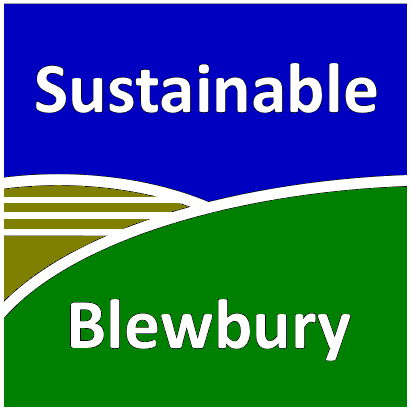
The Natural Environment and Heritage theme aims to raise awareness and promote protection of Blewbury's architecture and special characteristics – including its springs and streams, trees, and downland.
Background
Blewbury can trace its geological history back 350 million years. However, most of its visible features are the product of weathering and erosion in the past 12,000 years, since the last glacial period. There is evidence that people have been living here for about 4,000 years.
The Natural Environment and Heritage theme aims to raise awareness and promote protection of the landscape of the village of Blewbury and surrounding land in the parish. It is a baseline project for sustainable development, and thus focuses primarily on the biodiversity and wildlife of its downland habitats, together with its springs and streams, trees, and village fabric. The theme also includes Blewbury’s architectural heritage, and the skills needed to sustain the special local character of the village. It is linked to other village activities such as the Local History Group and the Archaeology Group.

Special projects in the past have included Blewburton Hill, notably the book A View from the Hill, and actions related to the Parish Plan and the Blewbury Neighbourhood Development Plan.
We welcome ideas and help for this broad theme. If you would like to get involved, or just want to be kept informed by email, please contact us at info@sustainable-blewbury.org.uk.
This page covers a variety of activities:
- Downland project
- Hedge-laying
- Wildlife corridor
- Millbrook project: the Cleve, springs and streams
- Village trees
- Village skills
- Blewbury bee group
- Blewbury Wagon
- Dark skies and tranquility
Background information about Blewbury’s water sources, springs and streams is on a separate page.
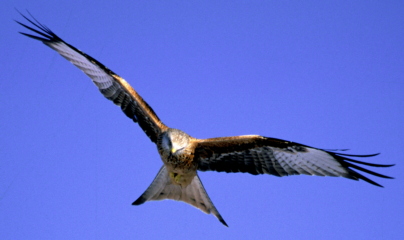
Blewbury is one of several spring-line villages, lying at the foot of a low escarpment forming the northern boundary of the chalk downs within the North Wessex Downs Area of Outstanding Natural Beauty (NWD AONB). There is a zoomable map showing the extent and boundaries of the AONB, which includes the entire village and its surroundings.
The southern part of the parish of Blewbury lies within this area of downland, much of which is given up to arable farming, although patches of land still retain characteristics of the original calcareous grassland which is one of the richest habitats in Europe. These remnants are being identified and studied for their intrinsic biodiversity. The area known as the Chalk Pit is an old chalk quarry reached via an ancient hollow way, Rubble Pit Lane, leading to it from the village. The quarry and the path contain a mosaic of habitats including lowland calcareous grassland, rank grassland, scrub and wooded areas. These areas together have been made a new Local Wildlife Site on the recommendation of the Berks, Bucks and Oxon Wildlife Trust (BBOWT).
The project was awarded a grant of £6057 by NWD AONB in January 2012. This has allowed the habitats to be managed and significantly improved by reducing the scrub and increasing the areas suitable for wildflowers. Where possible, the long grass has also been cut and removed in the autumn to give further help to the existing wildflower and insect populations.
Rubble Pit Lane: The area covered by Rubble Pit Lane, and the Chalk Pit at lower left, is outlined in red on the map below. Rubble Pit Lane has been much improved. The scrub has been greatly reduced where it was encroaching on the grass areas. The sections where the scrub and trees had already taken over completely were drastically cut back early in 2013 by Oxfordshire County Council (OCC) under their legal obligation to keep the lane open as a bridleway (photo). OCC collaborated closely with the project management, and the result is a wider, improved public bridleway and footpath with very much thickened hedges on each side giving much improved habitat for birds and other wildlife. The bottom two photos show the path as it was before (left) and after regrading (right).
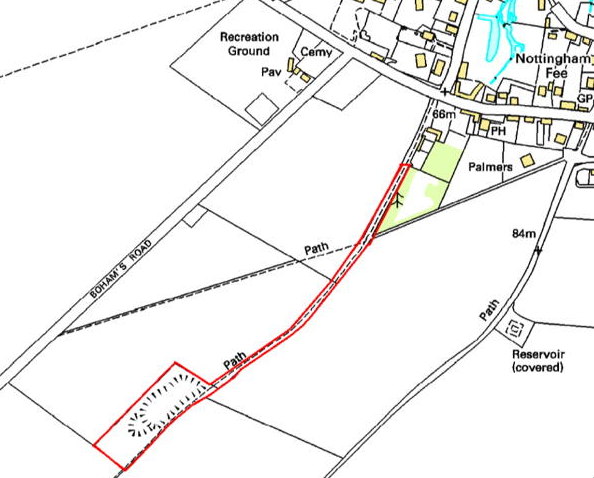
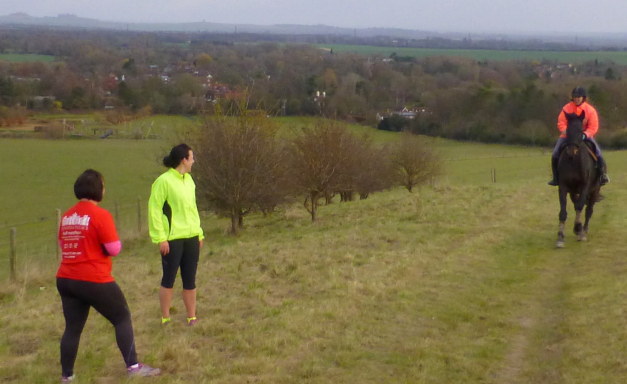
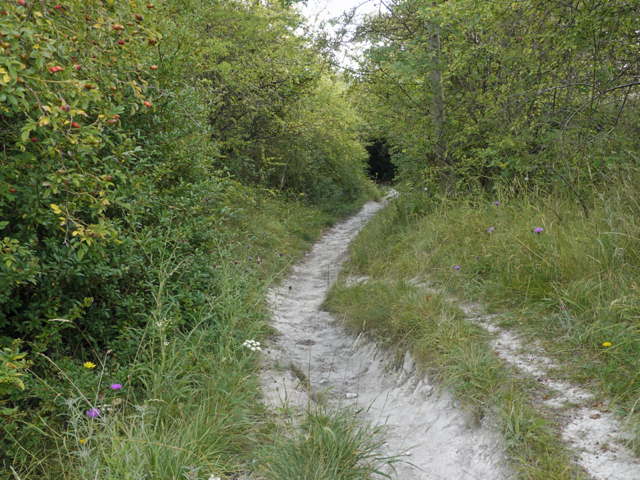
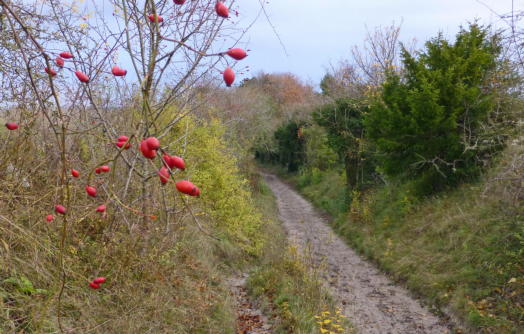
The Chalk Pit: The dense scrub, mostly hawthorn, has been much reduced by cutting and then poisoning the stumps. The remaining bushes provide some shelter and feeding habitat for birds without shading the grassland too much. The photo at left is an overall view of this former chalk quarry. Autumn grass cutting (photo at right) has allowed a marked increase in many species of wildflowers.
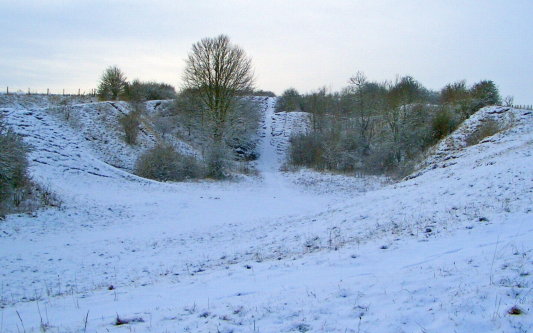
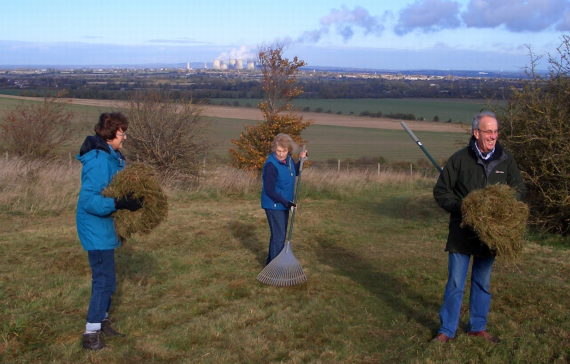
Tickers Folly Field: This is an area of about 2.5 hectares of grass, owned by the village, which in the past has been mown short throughout the summer months. By agreement with the Parish Council, just over a fifth of a hectare along the southern boundary is now under care as a wildflower meadow. Getting wildflowers to become established is a slow process, but experiments with different methods of propagation over several years have shown the way to better results. More than 20 new species are now to be found as a result of our efforts.
The best method has been to germinate seeds in trays, prick them out into small pots in spring and then plant out after several months when strong and healthy, and when conditions are favourable. Direct sowing of copious amounts of carefully gathered and purchased wild seed into scarified soil has been almost wholly unsuccessful. An exception to this has been the parasitic yellow rattle, which has taken very well from sowing in scarified patches and has benefitted the other plants hugely by weakening the coarse grasses. A total of 4500 wildflower plants have now been sown. Butterfly and bee numbers have increased markedly with the growth of the meadow and sheltering hedge.
The photos show autumn gentian, a large skipper butterfly on field scabious, a meadow pipit’s nest on Rubble Pit Lane, and toadflax.
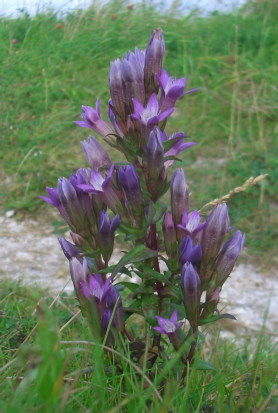
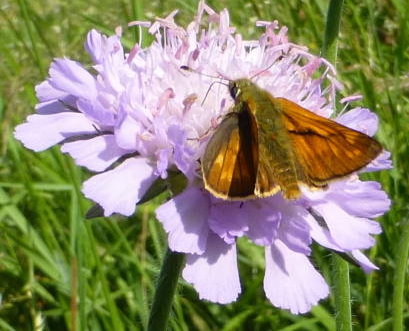
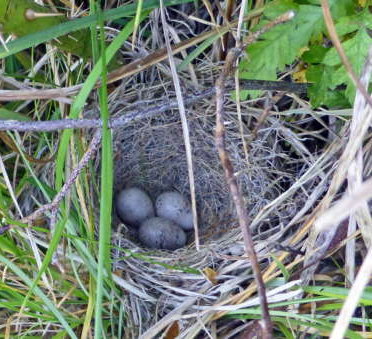
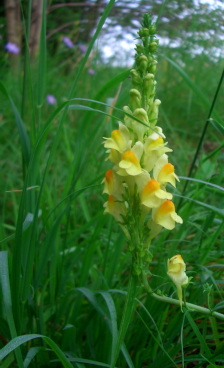
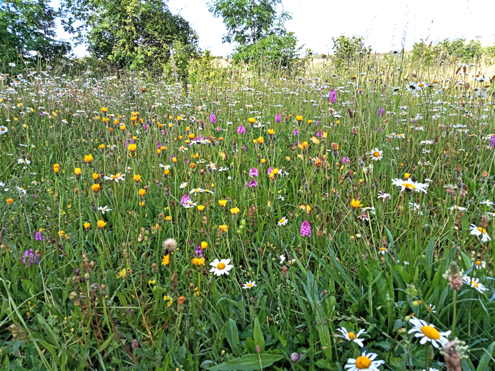
In 2019 the results of all the work were clear. There were well over two thousand cowslip flowers from the few hundred planted over the last four years, many of the original plants sporting a dozen or more flowers. 153 pyramidal orchids have been flowering. Field scabious, along with a great number of other common flowers like red clover, dropwort, toadflax, knapweed and kidney vetch were widespread. It is thought that many of the seeds sown in previous years have lain dormant, awaiting the right conditions to flourish. Even some quite rare species are established, including bee orchid, star of Bethlehem, and broomrape. The photo (at right) shows an overall view of part of the wildflower area.
Note: For a much more detailed description of this work, there is an article at the end of our July/August 2019 newsletter.
Living Churchyard: Churchyards are important sanctuaries for wild life. Some, such as St Michael’s Church in Blewbury, are especially valuable, having been reclaimed from ancient meadows or pastures. If they have never been ploughed or treated with artificial chemicals, the soil will be rich in the seeds of wildflowers. This project (supported by BBOWT and the Church and Parish Councils) won an award in 2001. There are four different habitats: hedgerow, wayside, woodland edge and ditch, and chalk meadow. The existing natural floral population has been augmented by other species and a sustainable mowing routine established. Currently, the maintenance routine is continuing and new native species have been planted. Coarse grass is still the main problem and yellow rattle has been introduced to reduce this.
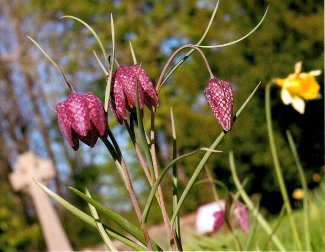
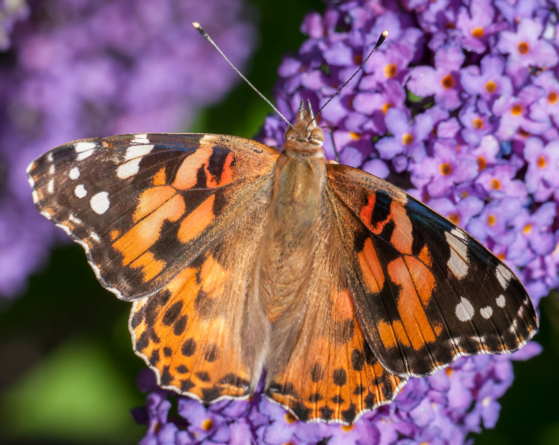

A note on ragwort: Ragwort is an important contributor to the natural biodiversity of the chalk downland, but it is toxic if eaten by horses. Ragwort grows in all three of the Downland Project areas: Tickers Folly, Rubble Pit Lane and the Chalk Pit. The Downland Project and Sustainable Blewbury are not responsible for the control of this weed, but it is taken seriously and efforts are made to keep it under control as part of the wildflower population. For a full description of the plant, with its benefits and dangers to wildlife, see the Defra Code of Practice (introduced July 2004). Some relevant notes from the Code are as follows:
Ragwort poisoning can have a devastating effect on horses in particular, as well as being damaging to cattle and other animals. Ingestion of Common Ragwort (Senecio jacobaea), either in its green or dried state, can cause serious liver damage, which can have tragic consequences for both animals and owners. ... However, in the right place, and where there is no risk to animal welfare, ragwort contributes to the biodiversity of the flora and fauna in our countryside.
By promoting good practice and good neighbourliness, the Code aims to reduce significantly the risk that horses and other livestock might be poisoned. It is intended for use by all landowners and occupiers.
The Code does not seek to eradicate ragwort, but only seeks to control it where there is a threat to the health and welfare of animals. We place a particular emphasis on protecting horses, whose digestive system makes them particularly vulnerable. The Code provides comprehensive guidance on when, where and how to control ragwort, but pays specific attention to the needs of the environment and the countryside as part of the process. The Code should benefit the environment by ensuring there is less damage to non-target species, by setting out clear parameters on when it is necessary to control ragwort and by recommending the use of non-chemical options for control where feasible.
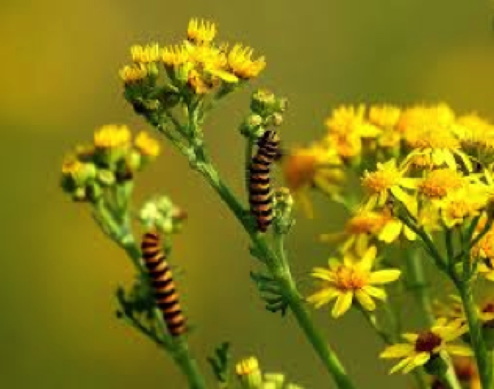
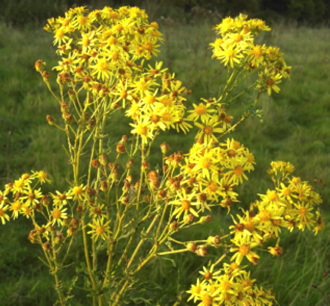
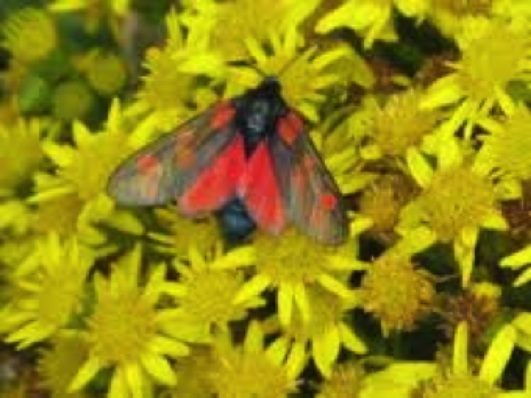
In the Downland project our method of control is to pull up the flowering plants before they seed. They come up fairly easily when the ground is wet but care has to be taken to wear gloves when handling them. They are disposed of in heaps, out of sight and out of the way of grazing animals. In 2014 the number of flowering plants going to seed was reduced to near zero. One problem is that only flowering plants can be seen easily. Some are allowed to grow and flower where cinnabar moth caterpillars (left-hand photo above) have been seen. The cinnabar moth (right-hand photo above) is a ‘priority species’ under the UK Biodiversity Action Plan, and so we have a responsibility to maintain this population. There are some research efforts in progress to develop a biological control method in certain circumstances using the cinnabar moth. So far this has not reached a usable stage.
Hedge-laying uses traditional techniques to improve the management of hedges in and around Blewbury. We usually lay hedges in autumn and winter to avoid disturbing nesting birds.
The three photos below shown an overgrown hedge before laying, the freshly
laid hedge, and the much denser result after a season of growing. The other photos show
the work being done. There is a more detailed article about our hedge-laying
in our Newsletter no. 14 (Dec. 2015, p.10). In our first three
winters we laid most of the hedges around Tickers Folly Field and the
cemetery, and since then we have continued with othr hedges around the village. If you are interested in helping,
please contact John Ogden:![]()
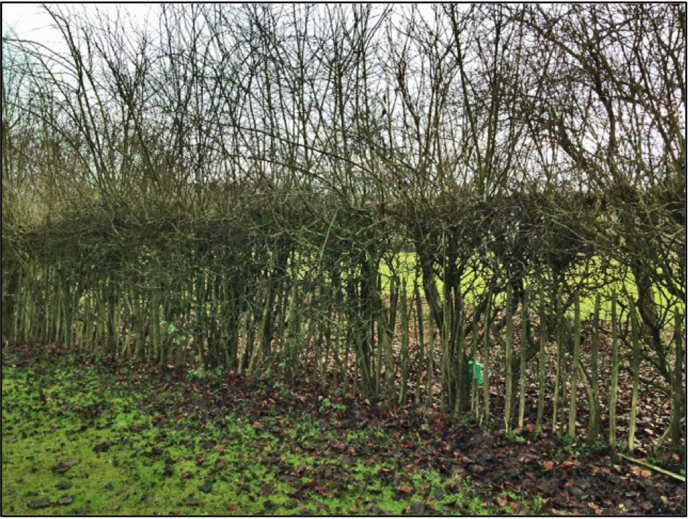
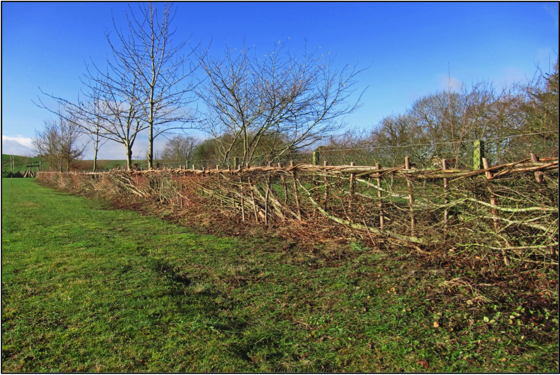
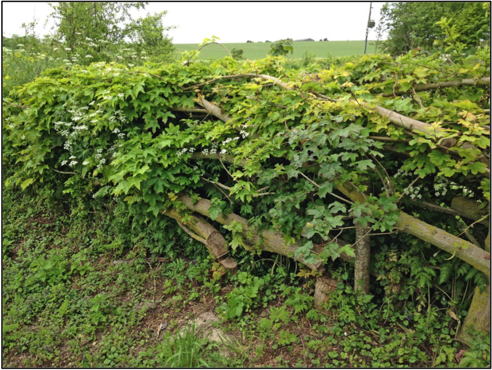
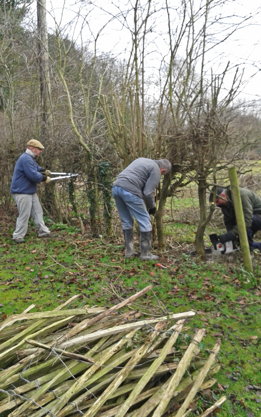
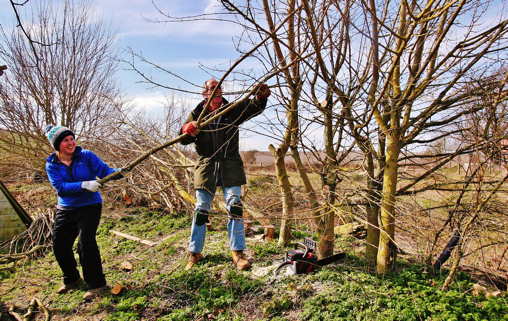
In December 2018 we laid the hedge along Coffin Way, the footpath from the western end of Blewbury to Upton. The photos below show the hedge before we started and work being done on the first day.
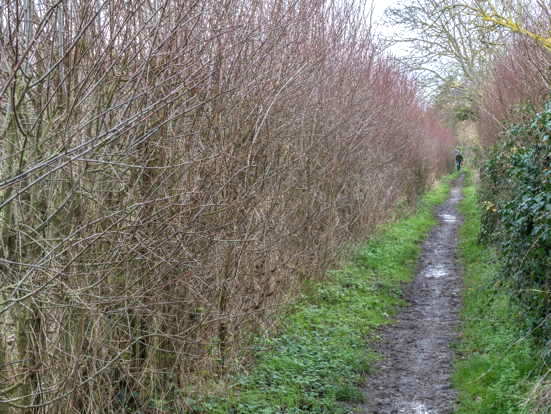
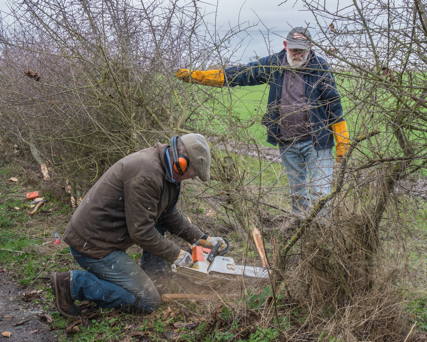
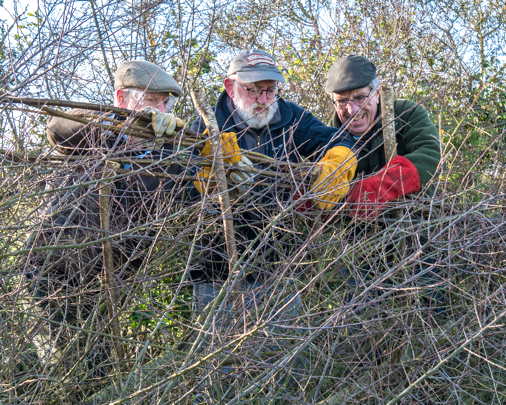
Working on Sunday mornings, by late Febrauary, we had finished the 190 metre long hedge:
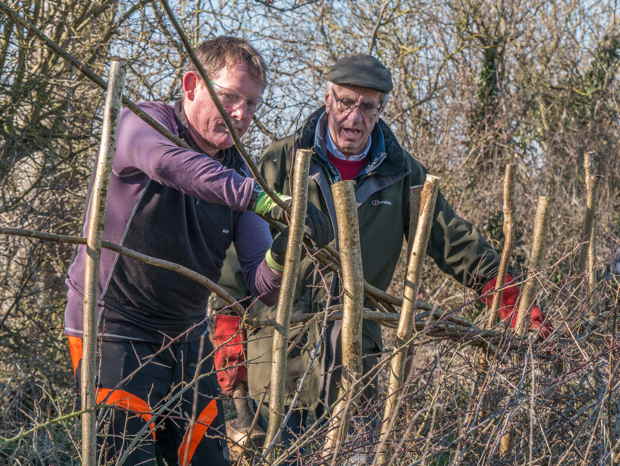
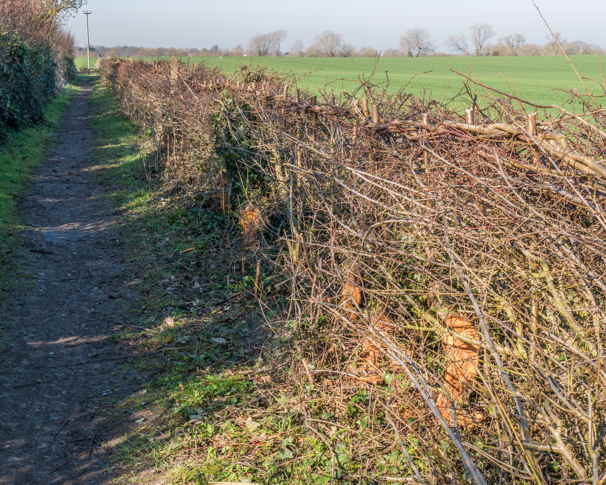
In the winter 2019–20 the very sparse hedge along the western side of Tickers Folly Field (parallel to the footpath up to the Chalk Pit) was laid where possible and additional trees and bushes planted in the gaps.
In September 2021 we had instruction from an expert and laid the hedge on the south and west sides our permaculture orchard-garden on Woodway Road, see the article in our newsletter no.47 (Nov/Dec 2021).
The Downland Project has worked over the years to restore the Chalk Pit and the ancient hollow way, Rubble Pit Lane. The next step was to connect this area with our other hollow way, Cow Lane, and the small woods on Churn Hill.
We started in 2017 by applying for a free pack of 100 tree saplings
from the Woodland Trust. A work party planted them around a small triangle
of land next to the Chalk Pit (see first two photos below). This is the start of a connection
from the Chalk Pit and Rubble Pit Lane to what’s left of the hedge leading
up to Churn Hill. They are all common woodland trees (hawthorn, hazel, dogwood,
wild cherry and silver birch) – we appreciate them for their flowers and fruit,
their colours and their scent, but together they provide the means of life
for countless insects and other animals, including fruit and nuts. In the winter of 2017-18 Beeswax Farming planted new hedge to fill in the
gaps in old hedges from the Chalk Pit up to Churn Hill and then along to the
path towards Cow Lane (third and fourth photos below). We hope that eventually this will be continued all the way across to Woodway. In winter 2019–20 the trees near the Chalk Pit were given added protection against deer and some new ones planted. And in March over a hundred trees and bushes from the Woodland Trust were used to fill in some of the gaps in the hedging planted by Beeswax, caused by some of the bushes dying during two very dry summers. If you would like to help with this, please contact
John Ogden:![]()
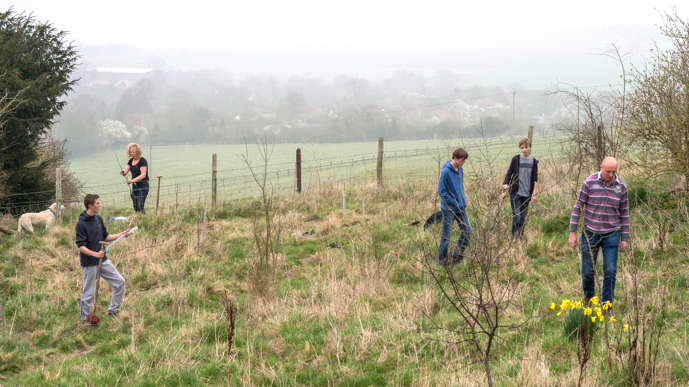
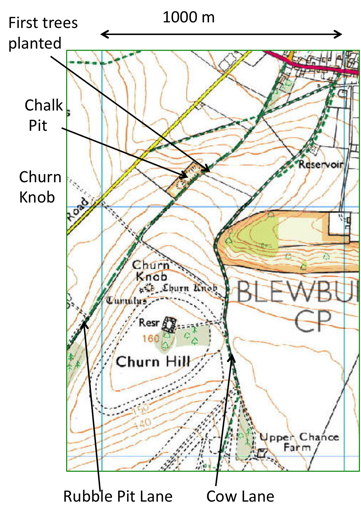
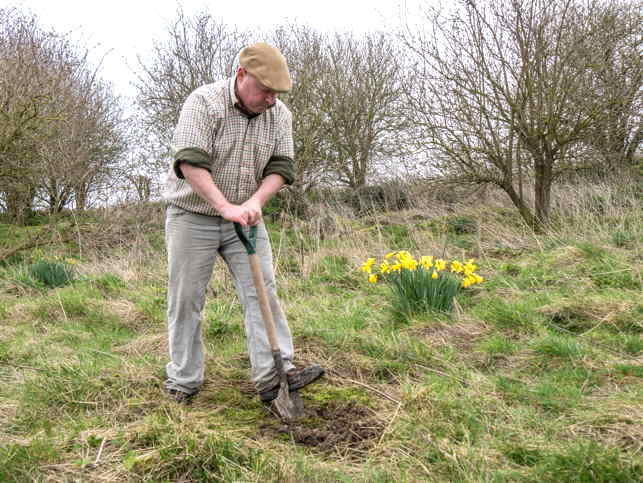
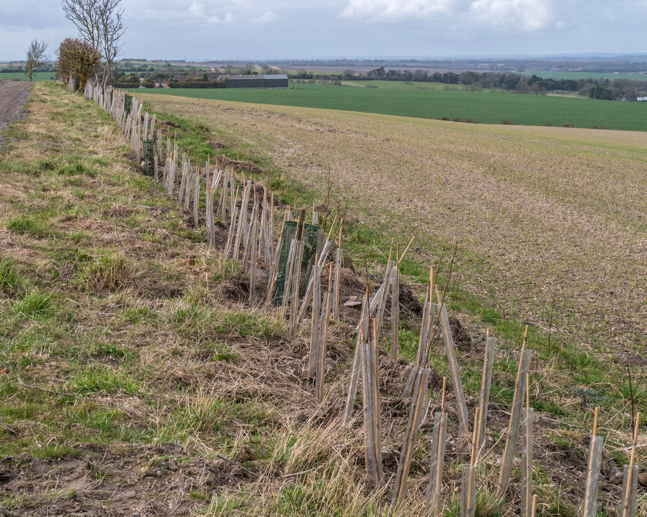
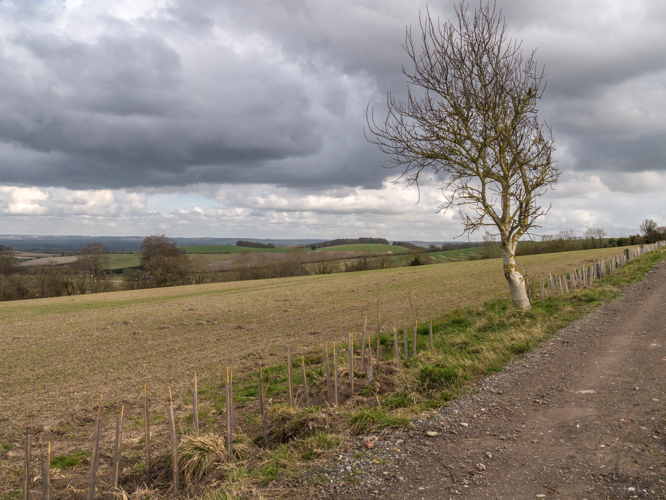
Millbrook project: the Cleve, springs and streams
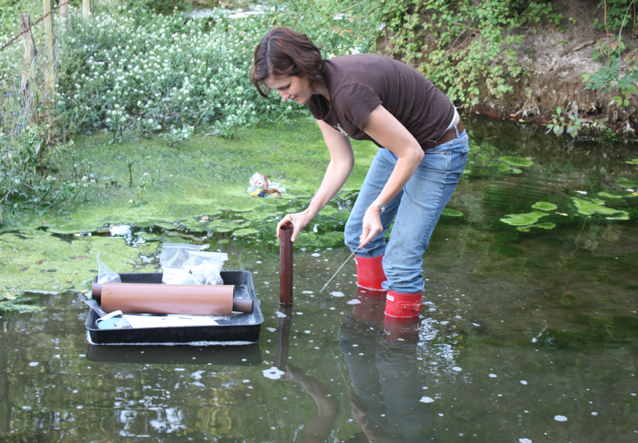
The Millbrook stream rises in the village as a series of springs along the bottom of the chalk escarpment and, along with the downland, gives rise to much of the special character of the village. We aim to survey all of the streams within the parish boundary for their biodiversity and ecology. We have been monitoring the hydrology of the springs for 25 years to better understand the flow characteristics and water quality. These were affected by the groundwater abstraction at Blewbury Pumping Station, but with its closure in 2007 there is now the opportunity to restore the health of the streams and their banks. The project focuses on restoration of the banks, an invertebrate survey, and monitoring of water voles and mink eradication. (Photo: sampling silt from the Cleve to determine its origin, July 2011.)
There is a separate page with more information about Blewbury’s water – the downs, springs and streams.
Restoration of the Cleve
The Cleve is a dynamic spring basin, and was formerly the site of the Blewbury watercress industry. It is fed by over 20 discrete springs, and the location of these is important in design of improved flows and as foci for improving ecology. Over the past 50 years or so the Cleve has been neglected and thick silt has accumulated, greatly reducing its ecological status. It is now agreed to be important to restore flow through the Cleve through a channel network capturing the spring flows, grading into wetlands. As far as possible we wish to restore the Cleve to a near-natural state with attention to landscaping.
First-stage funding was obtained for this project, including the following:
- Draw up a working map of the Cleve with location of springs, depth of silt, areas for channels and a planting scheme.
- Determine the origins of silt and requirements for its removal.
- Initial planting and creation of drawdown area.
- Consider landscape and amenity.
- Continue surveys of hydrology and hydrogeology, biology and ecology, and history.
- Community consultation.
Project status: September 2013
Despite the considerable amount of work undertaken, we had to call off – at least for the foreseeable future – any new work to restore and improve the Cleve. The position is that all available data for the hydrology and ecology of the Cleve has been analysed as a basis for any future work. However, grant bodies advise that any funding will depend upon having outline consent from all riparian owners (those bordering the water). This is because the Cleve is a ‘common pool resource’ with multiple ownership. We have such consent, indeed positive support, from all but one of the interested parties. The one objector to the plans means that they must be put on hold, despite the fact that there is wide agreement from consultants and public bodies that the proposals represent the best way forward for restoration. An integrated solution for the Cleve as a whole, in which all village interests are represented, is essential. A wider village consultation would only be taken once owners’ agreement was secured; no further actions or expenditure can be undertaken without acceptance that this is a community project.
An extended summary of the work undertaken is given here (pdf).
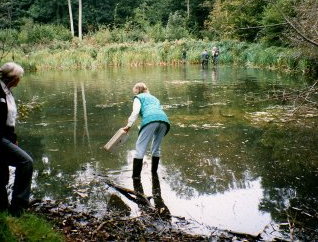
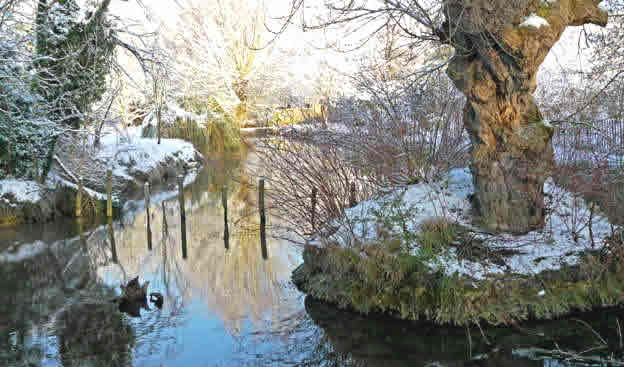
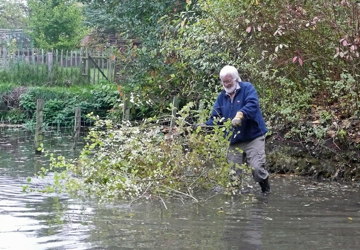
Invertebrate surveys
We are beginning a systematic survey of the Millbrook, working with the Environment Agency and the Riverfly Partnership – we are now part of their national river invertebrate monitoring programme that records the numbers of insect larvae present, and therefore the overall health of river systems. In June 2011 a lecture and practical demonstration were given to Blewbury schoolchildren (photos), and public demonstrations of the field technique were given at the 2011 Blewbury Festival.
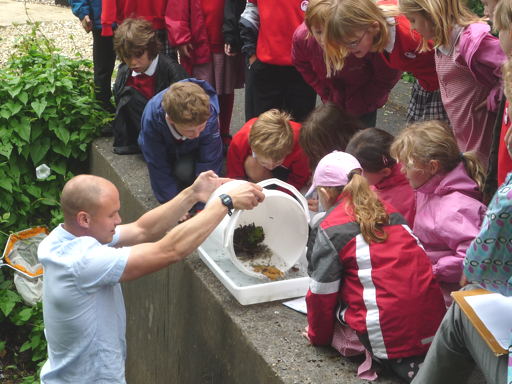
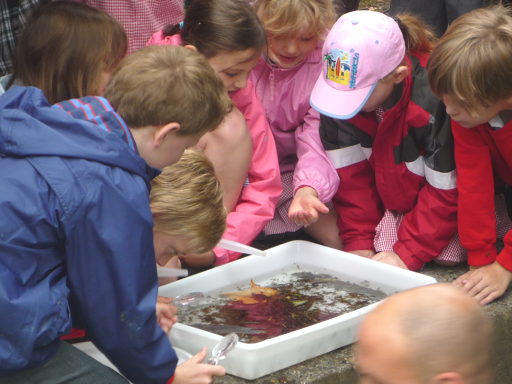
Water vole surveys and mink eradication
There have been sightings of water vole, and also mink, in the Millbrook. We are establishing a monitoring project with a view to restoring the former and eradicating the latter.
The village has a diverse landscape with many fine trees. This important heritage should be maintained, and where possible the landscape enhanced by additional tree planting and maintenance. We are working with the Parish Council on issues relating to planning, and programmes to plant new trees as well as to remove or prune trees for health and safety reasons. The start of the project was to establish a good database of the tree population.
From 2007 to 2009 most substantial trees in the public realm within the village, i.e. those along roads, footpaths and other open spaces, were identified and measured. Their girth, spread, height, position, condition, importance and history have been recorded. We have recently surveyed many trees in private gardens. A survey of trees in the wider parish of Blewbury remains to be done. A photographic record is being maintained – the photos show a weeping ash, trees at the edge of the downs, and a 600 year old yew.
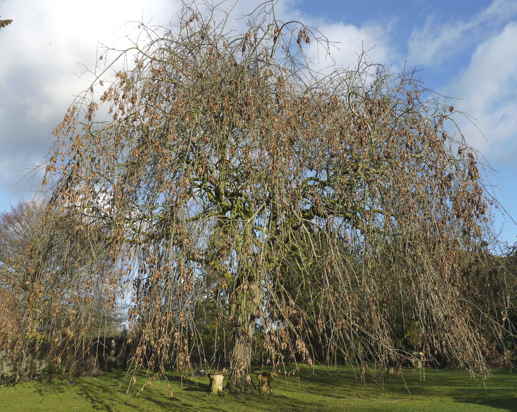
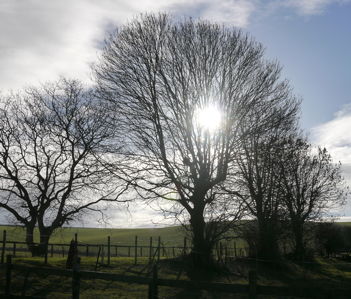
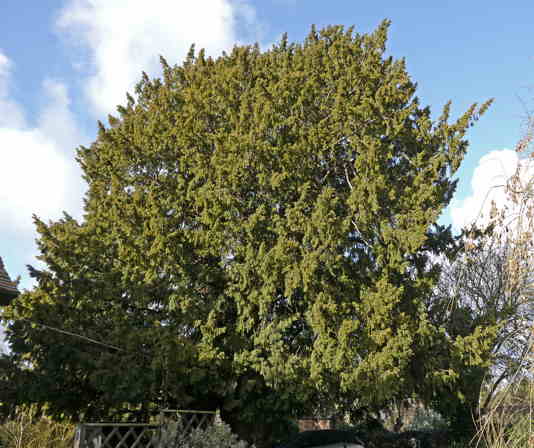
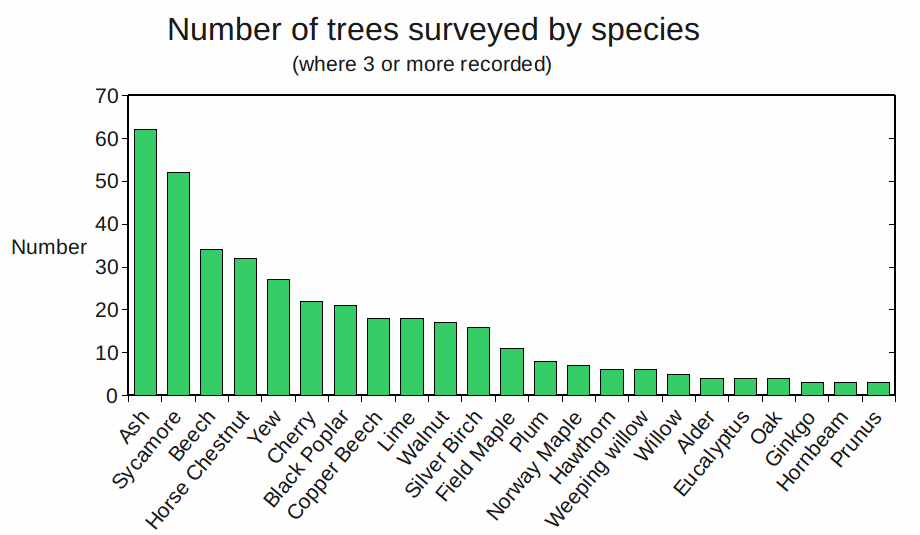
Trees are under threat from many sources including diseases such as ash dieback, vandalism, acts of God, and impending climate and environmental change. This survey provides a baseline against which future changes can be measured.
As part of the 2010 Apple Day (see our photo gallery), a survey of Orchards in and around Blewbury was completed and a booklet published. The photo shows most of the more than 57 apple varieties grown in Blewbury.
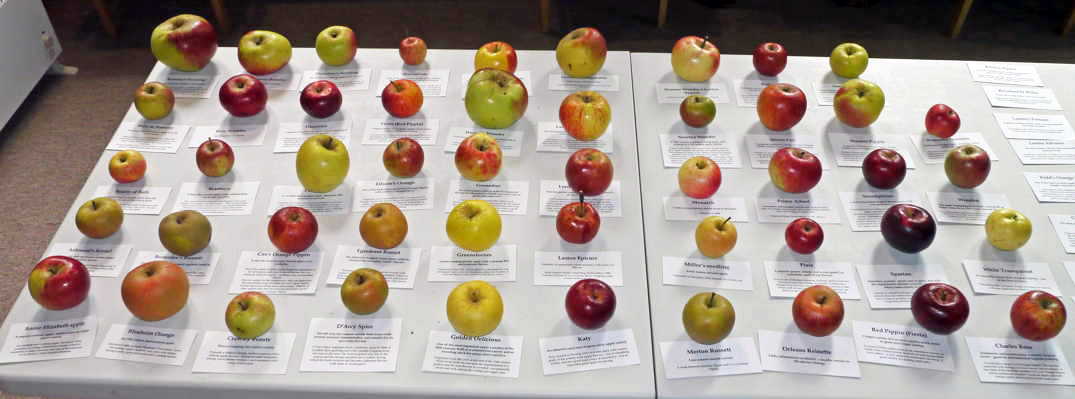
Blewbury, like many other villages in the Vale of White Horse, has a strong rural tradition and is slowly losing, or is in danger of losing, traditional skills. We are planning to start a re-skilling programme which will address not only the village fabric and buildings, but also encourage other ‘endangered’ crafts and pastimes. These might include bee-keeping and honey making, willow growing and basket making, coppicing, hurdle making and others.
Together with the Local History Group we have recorded the special architectural details of buildings (especially listed ones) and village fabric. A study of about 100 houses has revealed the wealth of beauty in brickwork, windows, doors, engravings, etc. The results have been written up and recorded photographically, and a local artists group will make its own contribution with drawings and sketches. This serves as a baseline study for understanding the skills and crafts upon which the village has depended in the past. It will also help with the next update of the Parish Plan.
It is hoped that this survey will help identify skill shortages for maintenance and repairs of historic buildings. Although most owners have so far had few problems finding skilled craftsmen, everyone is aware that specialist skills may not be available unless we can encourage new trades and apprentices. We will identify these skills shortages and look into how training schemes may be initiated, possibly with other local villages.
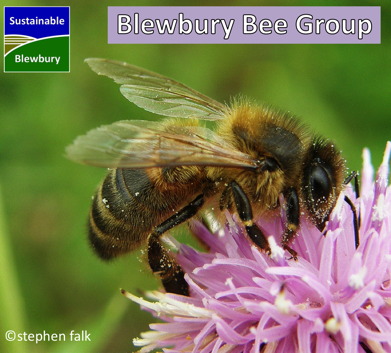
In response to the Friends of the Earth (FoE) Bee Cause campaign a small Blewbury Bee Group has been formed. The aim is to create local awareness of the vital importance of bees and other pollinators, help reverse the decline in their numbers and encourage beekeeping. We plan to publicise the plight of bees, and their need for food and homes as well as supporting the national campaign led by FoE and others through our website, other village and local media, and events. We held a launch event at the Green May Fair.
Twitter: @BlewburyBees
Contact: Debs Furness – DebsFurness@gmail.com
Useful links:
The Bumblebee Conservation Trust has information about bumblebee nests at:
bumblebeeconservation.org/about-bees/habitats/bumblebee-nests
bumblebeeconservation.org/about-bees/faqs/moving-bumblebee-nests
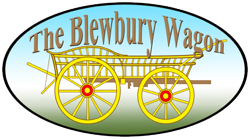
The Blewbury Wagon is a rare example of a four-wheeled Berkshire Bow Wagon, built in 1895. It is a poignant reminder of a time, only a hundred years ago, when the village and the land were one. Farmers, workers, wheelwrights, blacksmiths, carpenters and many other essential tradesmen lived in the houses with their families. Children, equipment and animals were everywhere. That way of life, little changed in a thousand years, is now all but gone but it formed the layout and structure of the village we still know and love today. The wagon is an evocative and beautiful symbol representing centuries of village life.
Now perfectly restored, its main purpose will be to enhance the everyday village scene for everyone in the community and for visitors to this historic and beautiful place. In addition it will be rolled out to grace special occasions such as village festivals, weddings and other gatherings. The dream, now fulfilled, was to see it harnessed to a heavy horse and drawn around the village as of old.
A brief history
The Blewbury wagon was originally owned by Frederick (Fred) Abbot, a local farmer, and was built by‘Berkshire Wagon’. This company was owned by a branch of the Napper family in East Hagbourne. Fred and Sarah Kate Humfrey were married in 1895. Their house on London Road is now called ‘Humfreys’. The wagon was a wedding gift from Sarah to Fred.
It arrived in Blewbury from the Abbott family in East Hagbourne around 1965 and over time became known as the Blewbury Wagon. It was purchased for the village for £10 by Roger Cambray. It was in a poor state but a small team of enthusiasts, including a carpenter, were able to restore it. Coral Richards has championed the wagon from that time and raised support and money for materials. Roger Cambray was a keen historian and saw to it that everything was done correctly right down to obtaining the correct traditional colours.
It was decorated and used to carry the May Queen and her assistants for a May Fayre and on another occasion the miracle play Noyes Fludde was performed on it in the Play Close.
It then stood for a number of years on show in a barnyard, but the weather took its toll and for several years it was stored in John Snook’s barn and later in Cambray’s barn at Great Tree. Coral and others tried very hard to find a wheelwright who would repair the historic vehicle. For a long time it seemed hopeless, and at the lowest point even erstwhile enthusiasts were tempted to scrap or burn it just to be relieved of the problem. It was still occupying space and it was very hard to justify its continued existence.
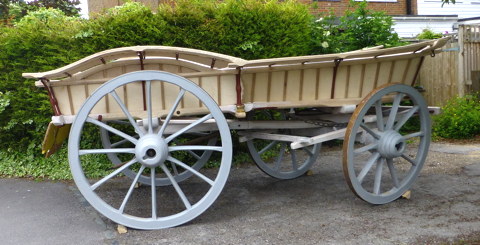
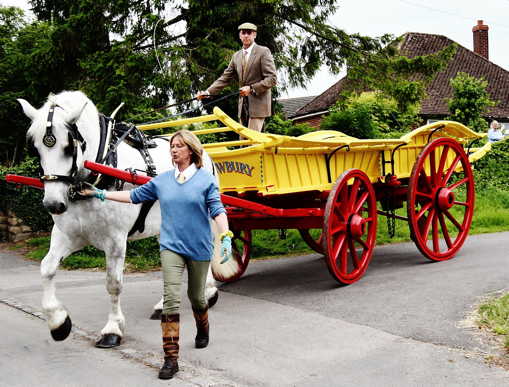
However, in 2010 Chris Cambray (Roger Cambray’s son) met the wheelwright Warren Blain at the Newbury show, where he was exhibiting both wagons and horses. Warren was deeply interested in the project from the start, and gave professional advice and a firm quote for the restoration. This enabled us to begin raising funds. Thanks to wonderful financial, practical and moral support from more than eighty individuals, Sustainable Blewbury, the Blewbury Bulletin, the Local History Society, the Women’s Institute, the Blewbury Village Society, the Blewbury Players and the Blewbury Festival Committee, more than £8000 was raised and the work was commissioned. In spite of a bad accident which prevented Warren from working for a long period, the rebuild was completed in time for the Blewbury Festival in 2013. It was on show, unpainted, with every beautiful timber and joint visible for inspection by the most discerning eye; oak, ash, elm and wrought iron all combined in truly traditional style (photo at left).
Its next appearance was at the 2014 Mini-Festival in June. It was fully painted in the correct traditional colours and, a dream come true, it was pulled by Warren’s own carthorse Gilbert through the village and to the Manor (photo at right).
The display shelter
The next part of the project was to make sure the wagon was visible in the village and not tucked away, out of sight and mind, as it has been for so many years. An application to the Heritage Lottery Fund to build a traditional open wagon shed in the centre of the village at Orchard Dene and to prepare a book about the project was readily granted. The owners of the site, Alastair and Zillah Laidlaw, kindly gave their permission for this and the funding was secured in January 2015. Work on the ground started in mid-April and the shelter was finished five weeks later. The shelter is a very traditional design, built of oak on a concrete base with a clay tile roof. In June the newly restored 120-year-old wagon was wheeled into its new and permanent home. The support and patience of all the people who contributed and helped with this project over the years was finally rewarded. Both the wagon and its shelter seemed to smile in the sunshine along with an impromptu gathering of people to witness and help with the quiet homecoming (left-hand photo by Bernard Mattimore).
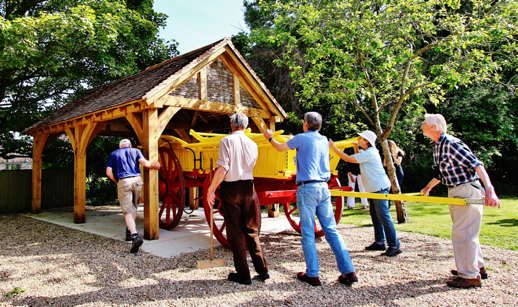
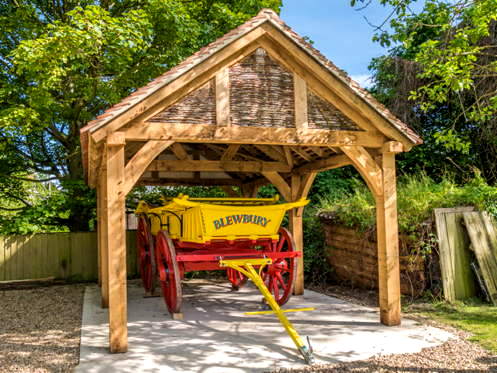
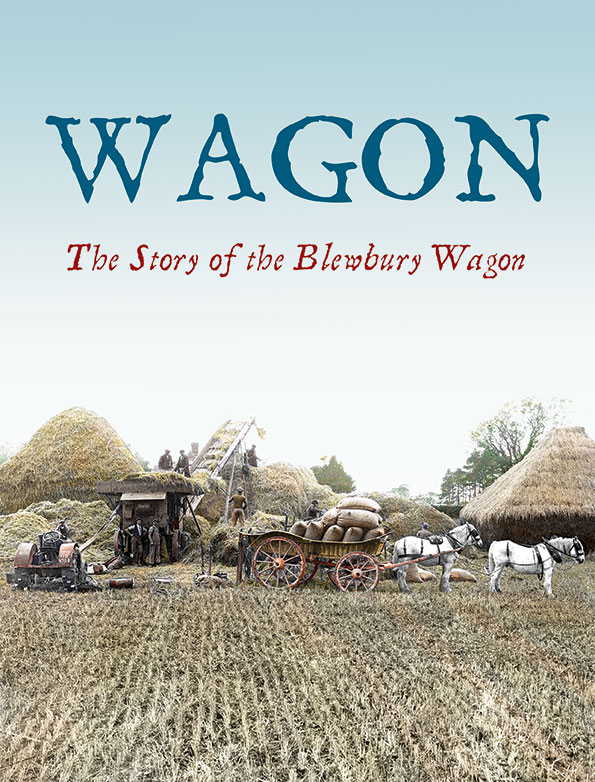
To complete the project a new book was launched in December 2015. It covers the life and times of the Blewbury Wagon from its creation in 1895 in East Hagbourne through to the beginning of its new life in Blewbury in 2015. The high-quality book is in full colour containing text, photos, paintings, drawings and poetry from the early part of the twentieth century as well as coverage of the recent restoration. It has been designed as a companion to A View from the Hill created by the same team in 2006. All profits from sales will be used to maintain and insure the wagon in the future. The book can be purchased for £10 at Blewbury Post Office, from Savages in Blewbury or from the author by post. Please email peter.cockrell@blewbury.net.
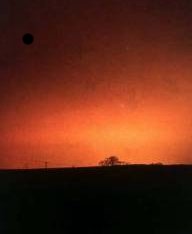
Blewbury is a village which has maintained a policy of having no street lighting. Light pollution is, however, still increasing, leaving less and less countryside where we can enjoy seeing the stars. Much of Blewbury's light pollution is due to sky glow from Didcot and towns even further away. Light pollution is wasted light which also wastes electricity. Outside lights can contribute to sky glow, and can also create glare and light trespass affecting others.
We are working with the Parish Council towards reducing light pollution, by ensuring that any lights shine downwards, are no brighter than necessary for safety, and only come on where necessary. We actively support the British Astronomical Association's Campaign for Dark Skies.
According to the CPRE, tranquility is the quality valued most in the English countryside. They have drawn up criteria for tranquil areas and we fully support their work in this area.
